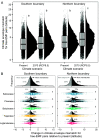Climate mismatches with ectomycorrhizal fungi contribute to migration lag in North American tree range shifts
- PMID: 38805274
- PMCID: PMC11161776
- DOI: 10.1073/pnas.2308811121
Climate mismatches with ectomycorrhizal fungi contribute to migration lag in North American tree range shifts
Abstract
Climate change will likely shift plant and microbial distributions, creating geographic mismatches between plant hosts and essential microbial symbionts (e.g., ectomycorrhizal fungi, EMF). The loss of historical interactions, or the gain of novel associations, can have important consequences for biodiversity, ecosystem processes, and plant migration potential, yet few analyses exist that measure where mycorrhizal symbioses could be lost or gained across landscapes. Here, we examine climate change impacts on tree-EMF codistributions at the continent scale. We built species distribution models for 400 EMF species and 50 tree species, integrating fungal sequencing data from North American forest ecosystems with tree species occurrence records and long-term forest inventory data. Our results show the following: 1) tree and EMF climate suitability to shift toward higher latitudes; 2) climate shifts increase the size of shared tree-EMF habitat overall, but 35% of tree-EMF pairs are at risk of declining habitat overlap; 3) climate mismatches between trees and EMF are projected to be greater at northern vs. southern boundaries; and 4) tree migration lag is correlated with lower richness of climatically suitable EMF partners. This work represents a concentrated effort to quantify the spatial extent and location of tree-EMF climate envelope mismatches. Our findings also support a biotic mechanism partially explaining the failure of northward tree species migrations with climate change: reduced diversity of co-occurring and climate-compatible EMF symbionts at higher latitudes. We highlight the conservation implications for identifying areas where tree and EMF responses to climate change may be highly divergent.
Keywords: climate change; ectomycorrhizal fungi; mycorrhizal symbiosis; range shifts; species distribution modeling.
Conflict of interest statement
Competing interests statement:The authors declare no competing interest.
Figures





References
-
- Memmott J., Craze P. G., Waser N. M., Price M. V., Global warming and the disruption of plant–pollinator interactions. Ecol. Lett. 10, 710–717 (2007). - PubMed
-
- Richman S. K., Levine J. M., Stefan L., Johnson C. A., Asynchronous range shifts drive alpine plant–pollinator interactions and reduce plant fitness. Glob. Change Biol. 26, 3052–3064 (2020). - PubMed
-
- Van der Putten W. H., Climate change, aboveground-belowground interactions, and species’ range shifts. Ann. Rev. Ecol. Evol. Syst. 43, 365–383 (2012).
MeSH terms
Grants and funding
LinkOut - more resources
Full Text Sources
Medical

